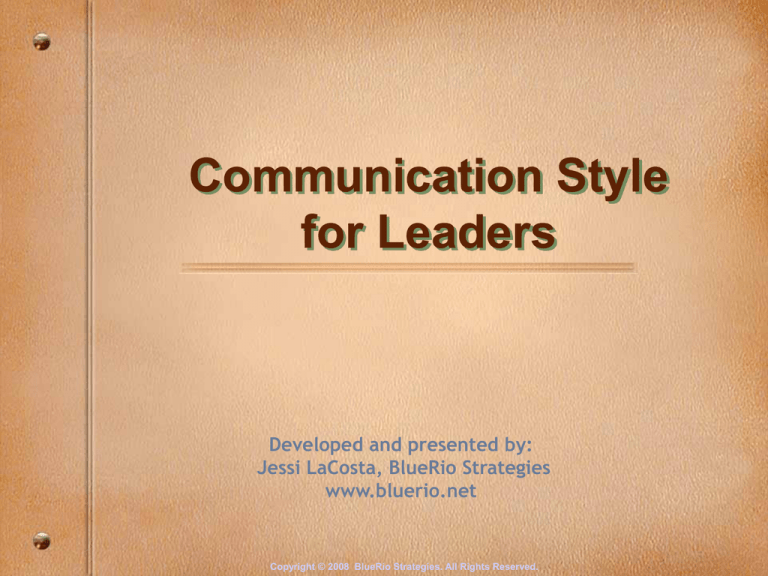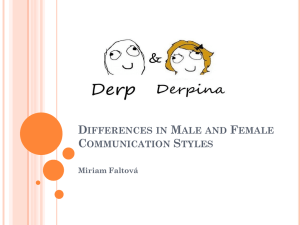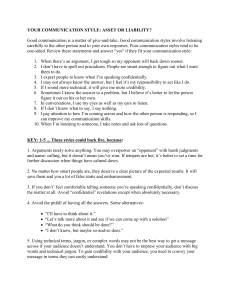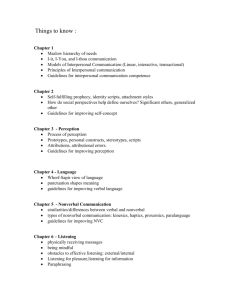
Communication Style
for Leaders
Developed and presented by:
Jessi LaCosta, BlueRio Strategies
www.bluerio.net
Copyright © 2008 BlueRio Strategies. All Rights Reserved.
“The difference between mere
management and leadership
is communication”
- Winston Churchill
www.bluerio.net
Today’s Agenda
1.
2.
3.
4.
5.
6.
7.
What is Communication
Natural Styles
Types of Communication
Tips for Active/Authentic Listening
Emotional Intelligence
FullSync© Steps to Prepare for Leadership Communication
Questions/Answers
Copyright © 2008. BlueRio Strategies. All Rights Reserved.
Is your perception always reality?
Do you see rectangles or squares?
Copyright © 2007. BlueRio Coaching. All Rights Reserved.
What is Communication?
•Connection allowing access between persons or places
•Verbal, visual, non-verbal
•Process by which information is exchanged between
individuals through a common system of symbols, signs,
or behavior
•Engagement
Copyright © 2007. BlueRio Coaching. All Rights Reserved.
What is Authentic Communication?
•Accepting responsibility
•Aligning messages with core values, goals, mission, vision
•Respectful transmission of ideas
•Always check assumptions (at the door)
•Honest
•What else?
Copyright © 2007. BlueRio Coaching. All Rights Reserved.
No one would talk much in society if they
knew how often they misunderstood others. - Johann Wolfgang Von Goethe
What is Leadership Communication?
•Effectively:
Motivating, directing, inspiring, guiding
•Results-oriented
•Often team-oriented
•What else?
Copyright © 2008. BlueRio Strategies All Rights Reserved.
Natural Communication Styles
How do these styles fit into the bigger picture?
•Controller/Director
•Promoter/Socializer
•Supporter/Relater
•Analyzer/Thinker
Based on the Platinum Rule by Tony Allansandra, PhD & Michael J. O’Connor PhD
Copyright © 2008. BlueRio Strategies. All Rights Reserved.
Natural Communication Styles
Another way to view styles: DISC
• "D" - Dominant
• "I" - Influence
• "S" - Steadiness
• “C" - Conscientiousness
Based on the 1928 work of psychologist William Moulton Marston.
Copyright © 2008. BlueRio Strategies. All Rights Reserved.
Natural Communication Styles
•Which one are you in a leadership environment?
•Which assessment style-guide works better for you?
•
•
•
•
Controller/Director
Promoter/Socializer
Supporter/Relater
Analyzer/Thinker
• "D" - Dominant
• "I" - Influence
• "S" - Steadiness
• “C" - Conscientiousness
Based on the 1928 work of psychologist William Moulton Marston.
Copyright © 2008. BlueRio Strategies. All Rights Reserved.
Natural Communication Styles
Scenario: You: owner/leader of a small business.
Situation: Chance to get a story in local paper
Need: A person to write it. (You must delegate)
Approach: Find staff - And:
Ask, tell, inform, demand?
Conflict: Tight deadline - no extra financial perks for staff. Who can handle
your style of communication - or how can you modify it to reach best person?
What would you do?
What style of communicator would that make you?
Copyright © 2008. BlueRio Strategies. All Rights Reserved.
Formats for Communication
•
•
•
•
•
•
Seminars
Email
Letters (snail mail)
PowerPoint
Video
Radio
•
•
•
•
•
•
•
Blogs
Mime
Dance
Art
Music
Conferences
What else?
Copyright © 2008. BlueRio Strategies. All Rights Reserved.
Listening
Three Levels of Listening:
•Level 1: Emphatic listening
•Level 2: Hearing words
•Level 3: Listening in spurts
From Leadership Communication by Deborha J. Barrett
Copyright © 2008. BlueRio Strategies. All Rights Reserved.
Active Listening
Style or tactic for listening that is about really “hearing” and
responding to another person or group in a way that fosters
mutual understanding. The focus is on the speaker.
Copyright © 2008. BlueRio Strategies. All Rights Reserved..
Active Listening
Authentic, Active Listening Tips
•Don’t interrupt
•Clarify (repeat back) your understanding of the message
•Empathize where you can
•Listen for emotions/ideas - in addition to words & facts
•Question when you do not understand
•Maintain Appropriate eye-contact
•Other forms of Listening? - Collaborative/Conversational
Copyright © 2008. BlueRio Strategies. All Rights Reserved.
It is ALSO about THEM
•Even when you are the speaker, (communicator) it is as
much about your audience
•Who is your audience
•How do they respond?
•What is the best delivery method?
•What happens if they DON’T get it?
Copyright © 2008. BlueRio Strategies. All Rights Reserved.
Emotional Intelligence
Basic Overview
•How emotionally savvy are you?
•How well do you know yourself?
•How well do you relate to others?
•How well do you deal with strong emotions - yours/others?
•How adaptive are you to change and problem solving?
Copyright © 2008. BlueRio Strategies. All Rights Reserved.
Emotional Intelligence (EI)
Basic Overview
Leadership Resonance vs.. Dissonance
“EI leaders follow the more lasting path to motivation
by evoking positive resonance: rallying people around
a worthy goal” - Primal Leadership
From Primal Leadership by Daniel Goleman, Richard Boyatzis, Annie McKee
Copyright © 2008. BlueRio Strategies. All Rights Reserved.
Phases/Stages of EI
Personal Competence:
•Self-Awareness
•Self-Management
Social Competence:
•Social Awareness
•Relationship Management
From Primal Leadership by Daniel Goleman, Richard Boyatzis, Annie McKee
Copyright © 2008. BlueRio Strategies. All Rights Reserved.
Emotional Intelligence & Leadership Styles
•Visionary
•Coaching
•Affiliative
•Democratic
•Pacesetting
•Commanding
From Primal Leadership by Daniel Goleman, Richard Boyatzis, Annie McKee
Copyright © 2008. BlueRio Strategies. All Rights Reserved.
Who fits into these categories?
• Rarely - if ever - do great leaders exhibit 100% perfection in all
domains of EI
• Who do you know - however - who exhibits strong capabilities
as an EI (emotionally intelligent) leader?
• What styles does this person normally use?
• How does this manifest in her/his communication?
Why FullSync Method?
• If you can “ACE” the steps of communication you are a very well -equipped leader.
• "Leadership is influence, nothing more nothing
less." What kind of influence do you have at
work? Do people listen when you talk?
John C. Maxwell - (an internationally recognized leadership expert,
speaker, and author)
FullSync & IACCE
•
•
•
•
•
Investigate
Authenticate
Connect
Engage
Evaluate
IAACE - I ACE!
Why Communication?
“Think about it. How do the best leaders motivate and inspire their people? Motivation
and inspiration comes with clear communication. How do the best organizations promote
discipline, accountability and strategic alignment? With clear communication. And how do
market leaders sell their products and services? With compelling ads and marketing
campaigns – in sum, by clear communication. The point itself is crystal clear: In real
estate, the old cliché is “location, location, location.” In business leadership, you preach
“communication, communication, communication.”
Lee Froschheiser, President and CEO of Management Action Programs,
IAACE - I ACE!
Why Authentic & Strategic
Communication?
•
Aligning vision & mission with method is key
•
Listening - being reflective is information gathering
•
Emotional Intelligence - skills to understand you and
your audience
•
FullSync Method - everything counts - when all is
insync - all is good.
Wrap-Up
Communication Styles:
Phases of EI:
EI - Styles of Leadership:
•Controller/Director
•Promoter/Socializer
•Supporter/Relater
•Analyzer/Thinker
•Self-Awareness
•Self-Management
•Social Competence
•Social Awareness
•Relationship Management
•Visionary
•Coaching
•Affiliative
•Democratic
•Pacesetting
•Commanding
• "D" - Dominant
• "I" - Influence
• "S" - Steadiness
• “C" - Conscientiousness
Wrap-Up
•
•
Active listening
Authentic listening
FullSync Method
•
•
•
•
•
Investigate
Authenticate
Connect
Engage
Evaluate
Questions?
Thank you.
619.401.6671 • www.bluerio.net • insightinsync.com






